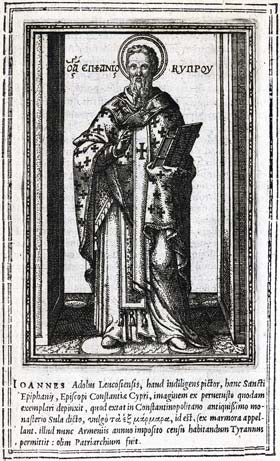
The inscription below the portrait says that Joannes Adolus Leucosiensis, "not a careless painter," painted the likeness of Epiphanius from a very ancient model (an icon) in the monastery of Sula in Constantinople.
Epiphanius was born in Judea after 310 CE; he died in 403 CE. He entered the monastic life in Egypt while he was still very young. On his return to Judea he founded a monastery and was ordained to the priesthood. In 367 he was appointed Bishop of Constantia (Salamis) a city on the Island of Cyprus, where he remained for nearly forty years, though his activity extended far beyond his island. His zeal for the monastic life, ecclesiastical learning, and orthodoxy gave him extraordinary authority; hence the numerous occasions on which his advice was sought, and his intervention in important ecclesiastical affairs. He travelled to Antioch, Rome, and Constantinople to combat the various heresies. He was on one of these excursions when he died on his return journey to Cyprus.
Epiphanius produced many works. The earliest (374) is the "Ancoratus", or "The Well-Anchored", i.e. the Christian firmly fixed against the agitations of error. The author argues especially against the Arians and the Origenists. In the "Ancoratus" Epiphanius confines himself to a list of heresies. Some readers desired to have a detailed work on this question, and Epiphanius composed (374-7) the "Panarion" or "Medicine chest", i.e. a stock of remedies to offset the poisons of heresy. This work is divided into three books comprising in all seven volumes and treating eighty heresies. The "Panarion" furnishes very valuable information concerning the religious history of the fourth century, because the author confined himself to transcribing documents preserved by him alone or wrote down his personal observations.
In theological matters Epiphanius taught the doctrine of the Catholic theologians of his time. In the vocabulary of Trinitarian theology he conformed to the language of the Greek Church. With regard to the constitution of the Church, he was one of the most explicit of the Greek theologians concerning the primacy of St. Peter. Two passages on the Eucharist are famous because they are among those which most clearly affirm the "Discipline of the Secret". The "Secret" was purely pedagogical and often neglected, consisting in grading the doctrinal initiation of catechumens and in not speaking before them of the Christian mysteries save in deliberately vague expressions. Epiphanius is one of the chief authorities of the fourth century for the devotion to the Blessed Virgin. He expresses himself on the subject in connection with two heresies, of which one diminished, while the other exaggerated, this devotion. A circumstance of his life is well known in the history of images, namely the destruction of an image in the church of Bethel.
His character is most clearly shown by the Origenist controversies, which demonstrated his disinterested zeal but also his quickness to suspect heresy, a good faith which was easily taken advantage of by the intriguing, and an ardour of conviction which caused him to forget the rules of canon law and to commit real abuses of power. He saw in Origen the chief cause of the heresies of his time, and especially of Arianism. He did not confine himself to this condemnation of Origen. He reproached the monks and bishops of his time with accepting the Origenist errors. Thence resulted at the end of his life the conflict with John of Jerusalem and with St. John Chrysostom.
Much of the work ascribed to Epiphanius during the Middle Ages was probably not written by him. He almost certainly was not involved in the writing of the Greek Physiologus attributed to him by Ponce de Leon, though he may well have read it. All of the texts attributed to him were collected by J.-P. Migne in his Patrologia Cursus Completus, Series Graeca.
Adapted in part from the Catholic
Encyclopedia

